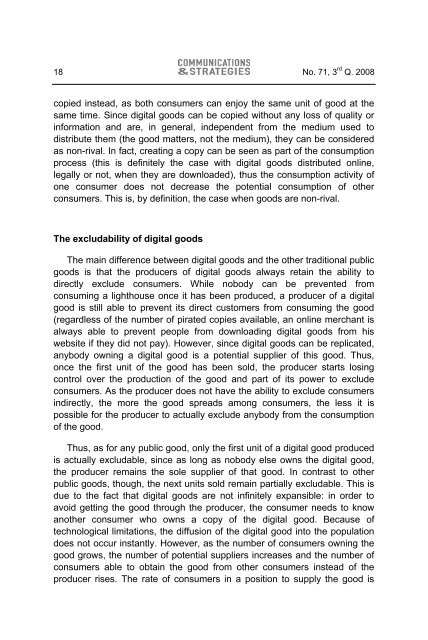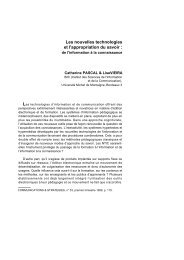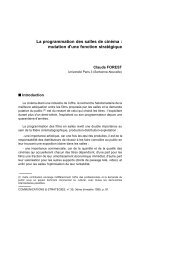The Nature of Digital Goods - Idate
The Nature of Digital Goods - Idate
The Nature of Digital Goods - Idate
Create successful ePaper yourself
Turn your PDF publications into a flip-book with our unique Google optimized e-Paper software.
18 No. 71, 3 rd Q. 2008<br />
copied instead, as both consumers can enjoy the same unit <strong>of</strong> good at the<br />
same time. Since digital goods can be copied without any loss <strong>of</strong> quality or<br />
information and are, in general, independent from the medium used to<br />
distribute them (the good matters, not the medium), they can be considered<br />
as non-rival. In fact, creating a copy can be seen as part <strong>of</strong> the consumption<br />
process (this is definitely the case with digital goods distributed online,<br />
legally or not, when they are downloaded), thus the consumption activity <strong>of</strong><br />
one consumer does not decrease the potential consumption <strong>of</strong> other<br />
consumers. This is, by definition, the case when goods are non-rival.<br />
<strong>The</strong> excludability <strong>of</strong> digital goods<br />
<strong>The</strong> main difference between digital goods and the other traditional public<br />
goods is that the producers <strong>of</strong> digital goods always retain the ability to<br />
directly exclude consumers. While nobody can be prevented from<br />
consuming a lighthouse once it has been produced, a producer <strong>of</strong> a digital<br />
good is still able to prevent its direct customers from consuming the good<br />
(regardless <strong>of</strong> the number <strong>of</strong> pirated copies available, an online merchant is<br />
always able to prevent people from downloading digital goods from his<br />
website if they did not pay). However, since digital goods can be replicated,<br />
anybody owning a digital good is a potential supplier <strong>of</strong> this good. Thus,<br />
once the first unit <strong>of</strong> the good has been sold, the producer starts losing<br />
control over the production <strong>of</strong> the good and part <strong>of</strong> its power to exclude<br />
consumers. As the producer does not have the ability to exclude consumers<br />
indirectly, the more the good spreads among consumers, the less it is<br />
possible for the producer to actually exclude anybody from the consumption<br />
<strong>of</strong> the good.<br />
Thus, as for any public good, only the first unit <strong>of</strong> a digital good produced<br />
is actually excludable, since as long as nobody else owns the digital good,<br />
the producer remains the sole supplier <strong>of</strong> that good. In contrast to other<br />
public goods, though, the next units sold remain partially excludable. This is<br />
due to the fact that digital goods are not infinitely expansible: in order to<br />
avoid getting the good through the producer, the consumer needs to know<br />
another consumer who owns a copy <strong>of</strong> the digital good. Because <strong>of</strong><br />
technological limitations, the diffusion <strong>of</strong> the digital good into the population<br />
does not occur instantly. However, as the number <strong>of</strong> consumers owning the<br />
good grows, the number <strong>of</strong> potential suppliers increases and the number <strong>of</strong><br />
consumers able to obtain the good from other consumers instead <strong>of</strong> the<br />
producer rises. <strong>The</strong> rate <strong>of</strong> consumers in a position to supply the good is





